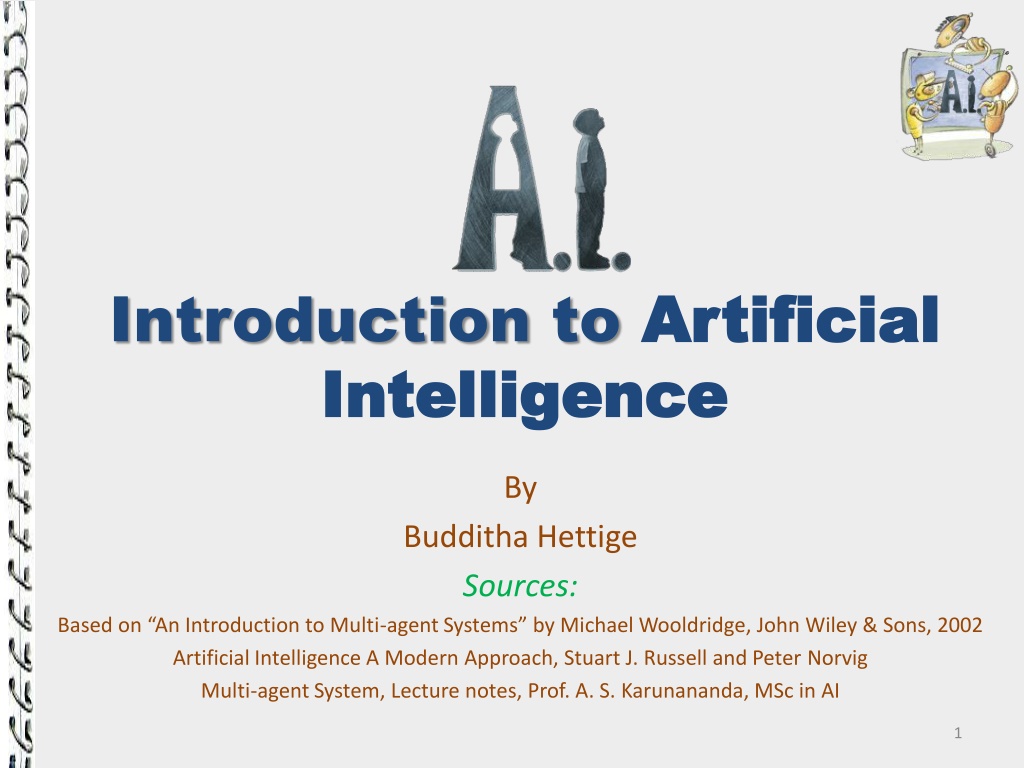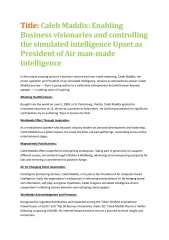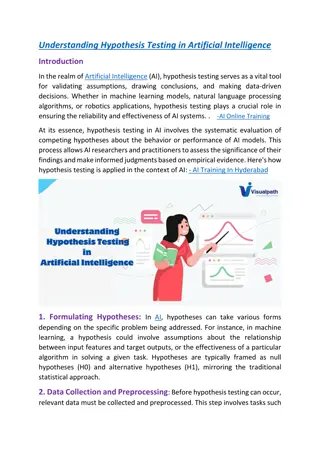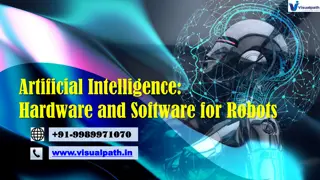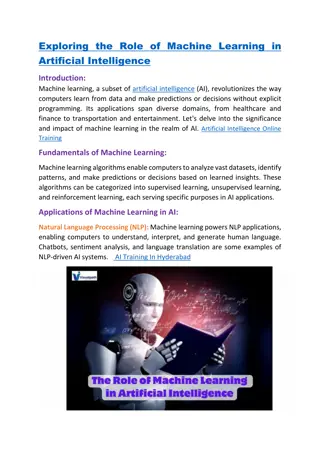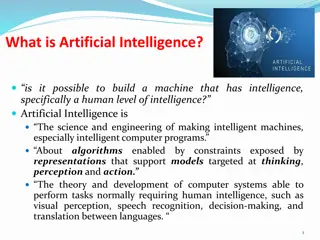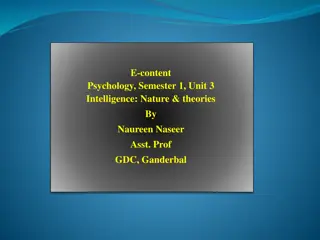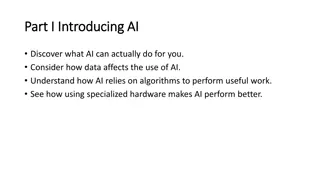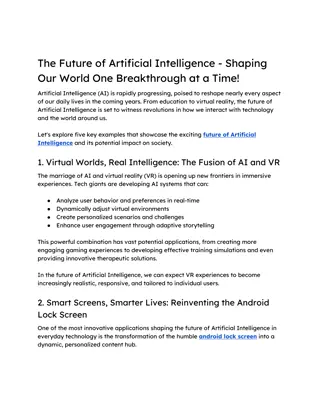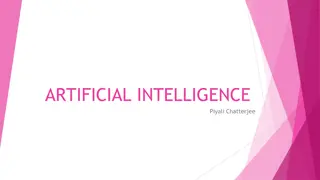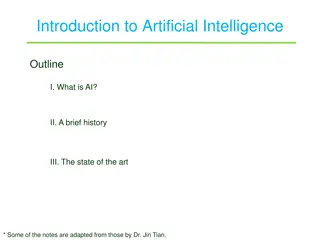Understanding Artificial Intelligence: A Comprehensive Overview
Dive into the realm of Artificial Intelligence (AI) to explore the concept of intelligence, the history of AI, success stories, examples, the capabilities of AI systems, the Turing test, and the various components involved in intelligence. Discover the disciplines that contribute to the development of AI and gain insights into building and understanding intelligent entities. Unravel the complexities of AI systems in practice and the fascinating realm of machine learning and adaptation.
Download Presentation

Please find below an Image/Link to download the presentation.
The content on the website is provided AS IS for your information and personal use only. It may not be sold, licensed, or shared on other websites without obtaining consent from the author. Download presentation by click this link. If you encounter any issues during the download, it is possible that the publisher has removed the file from their server.
E N D
Presentation Transcript
Introduction to Artificial Intelligence Intelligence Artificial By Budditha Hettige Sources: Based on An Introduction to Multi-agent Systems by Michael Wooldridge, John Wiley & Sons, 2002 Artificial Intelligence A Modern Approach, Stuart J. Russell and Peter Norvig Multi-agent System, Lecture notes, Prof. A. S. Karunananda, MSc in AI 1
Overview What is Artificial Intelligence? What s involved in Intelligence? History of AI Success Stories Examples Can Computers beat Humans? AI Systems in Practice 2
What is Intelligence? Intelligence: the capacity to learn and solve problems the ability to acquire and apply knowledge and skills. in particular, the ability to solve novel problems the ability to act rationally the ability to act like humans 3
What is Artificial Intelligence? Build and understand intelligent entities or agents Studies and develops intelligent machines and software 4
Acting humanly: Turing test Turing (1950) "Computing machinery and intelligence "Can machines think?" "Can machines behave intelligently? Operational test for intelligent behavior: the Imitation Game Suggests major components required for AI: - knowledge representation - reasoning, - language/image understanding, - learning 5
Whats involved in Intelligence? Ability to interact with the real world to perceive, understand, and act e.g., speech recognition and understanding and synthesis e.g., image understanding e.g., ability to take actions, have an effect Reasoning and Planning modeling the external world, given input solving new problems, planning, and making decisions ability to deal with unexpected problems, uncertainties Learning and Adaptation we are continuously learning and adapting our internal models are always being updated e.g., a baby learning to categorize and recognize animals 6
Academic Disciplines Mathematics Formal representation and proof, algorithms, computation, (un)decidability, (in)tractability Computer engineering Building fast computers Linguistics Knowledge representation, grammars 7
History of AI 1943: early beginnings McCulloch & Pitts: Boolean circuit model of brain 1950: Turing Turing's "Computing Machinery and Intelligence 1956: birth of AI Dartmouth meeting: "Artificial Intelligence name adopted 1950s: initial promise Early AI programs, including Samuel's checkers program Newell & Simon's Logic Theorist 1955-65: great enthusiasm Newell and Simon: GPS, general problem solver Gelertner: Geometry Theorem Prover McCarthy: invention of LISP 8
History of AI 1966 73: Reality dawns Realization that many AI problems are intractable Limitations of existing neural network methods identified Neural network research almost disappears 1969 85: Adding domain knowledge Development of knowledge-based systems Success of rule-based expert systems, E.g., DENDRAL, MYCIN But were brittle and did not scale well in practice 1986-- Rise of machine learning Neural networks return to popularity Major advances in machine learning algorithms and applications 1990-- Role of uncertainty Bayesian networks as a knowledge representation framework 1995-- AI as Science Integration of learning, reasoning, knowledge representation AI methods used in vision, language, data mining, etc 9
Success Stories Deep Blue defeated the reigning world chess champion Garry Kasparov in 1997 AI program proved a mathematical conjecture (Robbins conjecture) unsolved for decades During the 1991 Gulf War, US forces deployed an AI logistics planning and scheduling program that involved up to 50,000 vehicles, cargo, and people 10
Success Stories NASA's on-board autonomous planning program controlled the scheduling of operations for a spacecraft Proverb solves crossword puzzles better than most humans Robot driving: DARPA grand challenge 2003- 2007 2006: face recognition software available in consumer cameras 11
Knight Rider 12
IRobot 13
HAL: from the movie 2001 2001: A Space Odyssey classic science fiction movie from 1969 Part of the story centers around an intelligent computer called HAL HAL is the brains of an intelligent spaceship in the movie, HAL can speak easily with the crew see and understand the emotions of the crew navigate the ship automatically diagnose on-board problems make life-and-death decisions display emotions 14
Consider what might be involved in building a computer like Hal . What are the components that might be useful? Fast hardware? Chess-playing at grandmaster level? Speech interaction? speech synthesis speech recognition speech understanding Image recognition and understanding ? Learning? Planning and decision-making? 15
Can we build hardware as complex as the brain? How complicated is our brain? A neuron, or nerve cell, is the basic information processing unit estimated to be on the order of 10 12 neurons in a human brain many more synapses (10 14) connecting these neurons cycle time: 10 -3 seconds (1 millisecond) How complex can we make computers? 108 or more transistors per CPU supercomputer: hundreds of CPUs, 1012 bits of RAM cycle times: order of 10 - 9 seconds Conclusion YES: in the near future we can have computers with as many basic processing elements as our brain, but with far fewer interconnections (wires or synapses) than the brain much faster updates than the brain But building hardware is very different from making a computer behave like a brain! 16
Can Computers beat Humans at Chess? Chess Playing is a classic AI problem well-defined problem very complex: difficult for humans to play well 3000 Deep Blue Human World Champion 2800 2600 Points Ratings Deep Thought 2400 2200 Ratings 2000 1800 1600 1400 1200 1966 1971 1976 1981 1986 1991 1997 Conclusion: YES: today s computers can beat even the best human 17
Can Computers Talk? This is known as speech synthesis translate text to phonetic form e.g., fictitious -> fik-tish-es use pronunciation rules to map phonemes to actual sound e.g., tish -> sequence of basic audio sounds Difficulties sounds made by this lookup approach sound unnatural sounds are not independent e.g., act and action modern systems (e.g., at AT&T) can handle this pretty well a harder problem is emphasis, emotion, etc humans understand what they are saying machines don t: so they sound unnatural Conclusion: NO,for complete sentences YES, for individual words 18
A.L.I.C.E The A.L.I.C.E. AI Foundation promotes the adoption of the A.L.I.C.E. Free open source software for chatrobots, chat robots Chatterbots Chatterboxes http://alice.pandorabots.com 19
Can Computers Recognize Speech? Speech Recognition: mapping sounds from a microphone into a list of words classic problem in AI, very difficult Lets talk about how to wreck a nice beach (I really said ________________________ ) Recognizing single words from a small vocabulary systems can do this with high accuracy (order of 99%) e.g., directory inquiries limited vocabulary (area codes, city names) computer tries to recognize you first, if unsuccessful hands you over to a human operator saves millions of dollars a year for the phone companies 20
Can Computers Understand speech? Understanding is different to recognition: Time flies like an arrow assume the computer can recognize all the words how many different interpretations are there? 1. time passes quickly like an arrow? 2. command: time the flies the way an arrow times the flies 3. command: only time those flies which are like an arrow 4. time-flies are fond of arrows 21
Can Computers Understand speech? Understanding is different to recognition: Time flies like an arrow Assume the computer can recognize all the words how many different interpretations are there? 1. time passes quickly like an arrow? 2. command: time the flies the way an arrow times the flies 3. command: only time those flies which are like an arrow 4. time-flies are fond of arrows only 1. makes any sense, but how could a computer figure this out? clearly humans use a lot of implicit commonsense knowledge in communication Conclusion: NO, much of what we say is beyond the capabilities of a computer to understand at present 22
Can Computers see? Recognition v. Understanding (like Speech) Recognition and Understanding of Objects in a scene look around this room you can effortlessly recognize objects human brain can map 2d visual image to 3d map Why is visual recognition a hard problem? Conclusion: mostly NO:computers can only see certain types of objects under limited circumstances YES for certain constrained problems (e.g., face recognition) 23
AI Applications: Machine Translation Language problems in international business E.g., at a meeting of Japanese, Korean, Vietnamese and Swedish investors, no common language Or: you are shipping your software manuals to 127 countries Solution; hire translators to translate Would be much cheaper if a machine could do this How hard is automated translation Very difficult! e.g., English to Sinhala Not only must the words be translated, but their meaning also! Is this problem AI-complete ? 24
